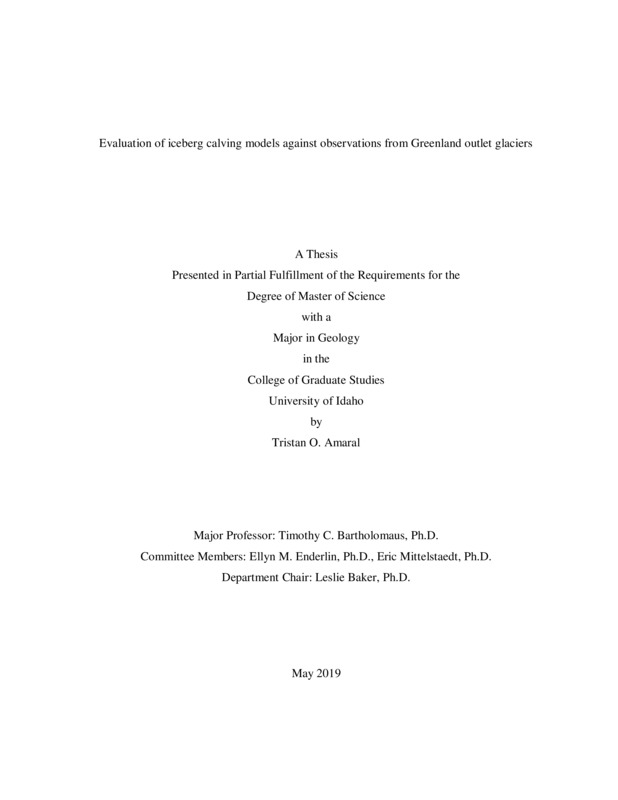Evaluation of iceberg calving models against observations from Greenland outlet glaciers
Amaral, Tristan. (2019-05). Evaluation of iceberg calving models against observations from Greenland outlet glaciers. Theses and Dissertations Collection, University of Idaho Library Digital Collections. https://www.lib.uidaho.edu/digital/etd/items/amaral_idaho_0089n_11593.html
- Title:
- Evaluation of iceberg calving models against observations from Greenland outlet glaciers
- Author:
- Amaral, Tristan
- ORCID:
- 0000-0002-8153-1369
- Date:
- 2019-05
- Keywords:
- calving glaciology Greenland Ice Sheet sea level rise
- Program:
- Geology
- Subject Category:
- Geophysics
- Abstract:
-
The retreat and advance of marine-terminating outlet glaciers in Greenland plays a critical role in modulating ice sheet mass balance. However, frontal ablation processes that regulate glacier terminus position are challenging to observe and thus difficult to represent in numerical ice flow models. Current models of the Greenland Ice Sheet rely upon simple iceberg calving and submarine melt criteria to parameterize the ice/ocean boundary as either a stable terminus position or ice ablation rate, yet the relative accuracies and uncertainties of these criteria remain largely unknown at the ice sheet scale. Using observations and model outputs from a representative sample of 50 marine-terminating outlet glaciers, we evaluate six iceberg calving models, including those considering height above buoyancy, crevasse penetration depth, von Mises stress, strain rate eigenvalues, and near-terminus ice damage. We optimize the free parameter value in each calving model and quantify associated model uncertainties in terms of the misfit between modelled and observed frontal ablation quantities. We find that five of six models tested can successfully reproduce terminus conditions across 50 sample glaciers with zero median model bias using a single, spatially-optimized parameter value. Evaluation of calving models against time series observations from individual glaciers suggests calving models that predict a terminus position can better account for seasonal terminus dynamics using a single, optimized parameter value than calving models that predict a frontal ablation rate. Overall, our results indicate that the crevasse depth calving model reproduces observed terminus dynamics with high fidelity and should be considered a leading candidate for use in predictive glacier and ice sheet models.
- Description:
- masters, M.S., Geology -- University of Idaho - College of Graduate Studies, 2019-05
- Major Professor:
- Bartholomaus, Timothy C
- Committee:
- Mittelstaedt, Eric; Enderlin, Ellyn M
- Defense Date:
- 2019-05
- Identifier:
- Amaral_idaho_0089N_11593
- Type:
- Text
- Format Original:
- Format:
- application/pdf
- Rights:
- In Copyright - Educational Use Permitted. For more information, please contact University of Idaho Library Special Collections and Archives Department at libspec@uidaho.edu.
- Standardized Rights:
- http://rightsstatements.org/vocab/InC-EDU/1.0/

